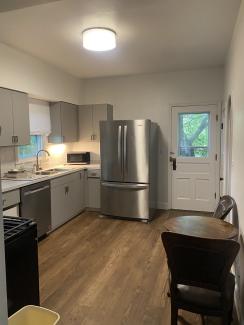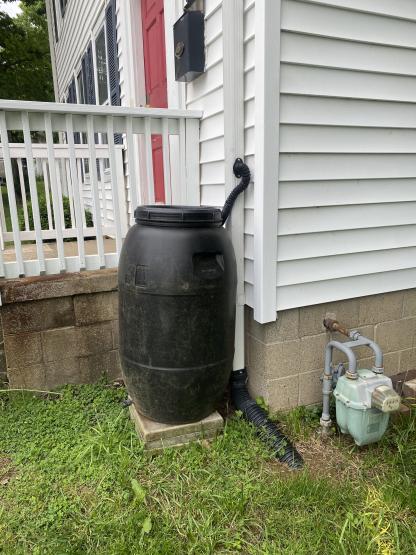
Home Features
Whether in the kitchen, the garden, or the laundry room, the OHIO Ecohouse provides residents with a myriad of useful tools, appliances, and opportunities that maximize energy efficiency and minimize environmental impact. Below, you can find information on specific, unique property features, both indoors and outdoors, that aid students in living their most sustainable lives.
Outdoor Features
Landscaping
The landscape at the OHIO Ecohouse is managed by those who live there, with past and present residents working diligently to invest in sustainable agricultural practices on the grounds. Previously, residents have taken part in workshops on permaculture, organic gardening, and composting - wherein participants learned to plan and implement such designs at the old Ecohouse property. Additionally, invasive plant removal in the native beds around the perimeter of the house led to the establishment of a new Pawpaw bed, highlighting a native plant and local novelty.
In 2015, the Ecohouse was designated as a Monarch Waystation and a National Wildlife Federation Certified Wildlife Habitat, which means that the Ecohouse landscape provides a variety of host plants, food sources, and appropriate environmental conditions to support native pollinators and wildlife. This is the first designated site on the Ohio University campus.
Solar Panels


The recently installed solar array at the new Ecohouse was installed by Appalachian Renewable Power (ARP), a solar installer based in Ohio and West Virginia. Since 2008, they have worked across the tri-state area as a residential solar installer of PV arrays designed to harness the power of the Appalachian sun into electricity for homeowners. In the summer of 2025, ARP installed a PV array in the front yard of the new Ecohouse property, between the Hungry Cat food truck and the Episcopal Church of the Good Shepherd. As they are implemented throughout the upcoming school year, additional information regarding their use by Ecohouse residents will be made available on this site.

The Garden
The garden at the OHIO Ecohouse began as a residence project in 2011. That fall, residents worked with staff in the Office of Sustainability to transform empty space into a campus community garden. A number of volunteers from across campus assisted with work days to clean up the space and build raised beds for students, faculty and staff who wished to "adopt" a plot. Plots are offered at no cost to any member of the campus community who is willing to agree to the Garden Rules.
In Fall 2012, the Ecohouse served as a living laboratory for the Food Cycle Service Learning Series. Faculty participating in the Common Experience Project on Sustainability were able to bring students to workshops where students learned how to harvest, prepare and preserve home grown produce. The canned food was utilized in a free community meal in Nelsonville, Ohio made and served by Ohio University students.
The OHIO Ecohouse Community Garden is an organic garden; plot adopters are unable to use chemical fertilizers or pesticides on any of the plots or surrounding areas. This rule is put into place to uphold the mission of the OHIO Ecohouse as a living learning model on sustainable living. Chemical fertilizers and pesticides are petroleum-based, chemical-heavy products that can have devastating impacts on local waterways, ecosystems, and wildlife.
The Garden Manager Graduate Assistant from the Office of Sustainability works with garden plot adopters and volunteers to provide proper education on effective sustainable gardening practices. Any individuals or organizations affiliated with the university who are interested in adopting a plot may do so by completing the Garden Plot Application Form. No experience necessary.
Weatherizing
Many college students experience frustration with inefficient rental units during the winter months. Since most students rent their off-campus homes for a temporary amount of time, they are reluctant to make significant financial investments in upgrading their home's efficiencies. This causes energy bills to peak during the winter months and, in some cases, for students to be uncomfortable in their own home.
Ecohouse residents are encouraged to tackle the issue of weatherization each winter by engaging in the following activities:
- Windows: When possible, storm windows are installed. Windows that do not possess similar capabilities to storm windows often utilize plastic sheeting to keep cold drafts from entering the home. Proper installation and sealing (using a hairdryer to "shrink" the sheeting) is necessary for both efficiency and resident comfort. A loose plastic sheet on a drafty window, on the other hand, creates a distracting noise and may be unsightly.
- Doors: If a resident notices that a door is allowing a draft into the home, they are encouraged to create a "door draft dodger" by placing a towel along the bottom of the door or installing a simple draft stopper.
- Fireplace: The fireplace at the Ecohouse is plugged which restricts cold airflow into the home. If you have a home with a fireplace, be sure that the flue is closed when not in use.
- Insulation: During the beginning stages of the Ecohouse's renovations, COAD (Corporation for Ohio Appalachian Development) performed an audit on the house in order to determine what efficiency measures would be most effective. During the winter months, proper insulation was identified as an area poised to significantly improve energy efficiency. In the past, residents have taken additional steps to insulate the house such as adding shrinking plastic to the windows in order to retain heat.
Ohio University's Office of Sustainability has partnered with Sugarbush Foundation and COAD to offer OHIO students with workshops on energy efficiency practices in the home. These workshops are free to all OHIO students and will tackle many issues that renters confront in their homes, including those practices listed above. For a full listing of these workshops, check out the calendar of events available at www.ohio.edu/sustainability.
Indoor Features
Compost Bins
Composting is a process where organic matter decomposes at an accelerated rate. This process differs from biodegrading as it is accelerated due to a higher temperature in a controlled environment. Composting is an aerobic process that required the correct carbon to nitrogen ratio for proper breakdown to occur. Composting is temperature-dependent and determines the speed at which the material breaks down. The Ecohouse is home to three different composting systems:
- Barrel Composter: Residents collect their kitchen scraps in a small bin in the house, empty that bin into a larger barrel, combine it with "brown waste" (such as newspaper or landscape waste) and then occasionally spin the barrel to aerate the contents. The resulting material is a nutrient-rich compost amendment that is used on the Ecohouse landscape instead of petroleum-based fertilizers.
- Worm Composting: A worm composting system is located in the basement of the Ecohouse. The framework for the system consists of a series of bins stacked vertically in which the worms reside. As they process the food waste and turn it into compost, they travel vertically through the bins. Moist newspaper is added to the bins in order to stabilize moisture for the worms. Residents add half of a pound of food per pound of worms.
- Heap Composting: The Ecohouse Community Garden features a heap composting unit for the gardeners to utilize. This is a simple open-air, three-bin system made out of used wood pallets. Gardeners are asked to use this composter for their unwanted/spoiled food and plant clippings. Weeds are dried by the sun on a tarp prior to being placed in the bins to avoid contamination of invasive species.
All three of the above options are viable options for any home composter. Supplies can be found locally.

Appliances
Refrigerator: The refrigerator/freezer at the new OHIO Ecohouse is Energy Star Qualified, meaning that it is in the process of being approved by the Environmental Protection Agency as an energy efficient appliance. Additionally, the specific Whirlpool model present in the new Ecohouse kitchen has been approved by the Association of Home Appliance Manufacturers as a sustainable choice. Since fridges are often the most energy consumptive products in any home, residents are asked to keep both the fridge and freezer appropriately stocked and to ensure doors are always tightly closed.
Dishwasher: Not only does the Ecohouse kitchen boast a plethora of cabinet storage and counter space, it comes fully equipped with a dishwasher as well. Built for durability and longevity, its large carrying capacity helps residents maximize its efficiency. Although not yet Energy Star Certified, the present model is a part of the Maytag EcoSeries, a line of appliances designed to save water, energy, and money.
Washing & Dryer: Located in the basement of the new Ecohouse, residents will be able to enjoy the luxury of onsite laundry using two Energy Star Qualified appliances. Both washer and dryer are designed to save water, energy, and money - similarly to other appliances in the home - and provide residents with access to customizable cycles such as "EcoDry" and "Quick Wash" that may aid in lessening their impact on the environment.
Energy Efficiency
Lighbulbs and Electricty: While the house has plenty of natural lighting which is heavily utilized by residents, all Ecohouse light fixtures are equipped with LED (Ligh Emitting Diode) lightbulbs, which produce light at a rate approximately 90% more efficient than incandescent bulbs. Although they may have a higher up-front cost, they save much more energy over their lifespan, and last longer than CFLs (Compact Flourescent Bulbs) and incandescents. To learn more about the benefits of LEDs in your own home and in the Ecohouse, check out this helpful page from the Energy Star website! In addition to energy-saving lighbulbs and appliances, the new Ecohouse comes equipped with a SPAN Smart Electrical Panel, designed to help residents track energy usage throughout their home, reduce their electrical footprint, and ultimately save money. This panel is still in the process of being installed at the new Ecohouse - more details are soon to come!
Programmable Thermostat: This feature allows residents to heat or cool the house only when they are home, saving energy by eliminating unnecessary use of the furnace and air conditioning.

Water Conservation
Reduced water per flush: The toilet tank has a 2 liter bottle of water taking up space, thus reducing the amount of water used per flush.
Rainwater: Two rain barrels - one at the front of the house and one on the side - collect rainwater from the gutters. The water collected is used on landscaping, in the garden, and for household efforts.
Low Flow Shower Head: The shower is equipped with a low-flow high-pressure shower head that greatly reduces the amount of water consumed from showering.